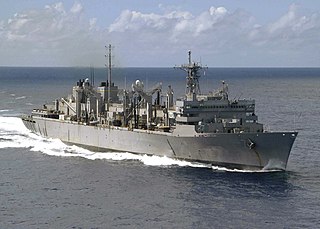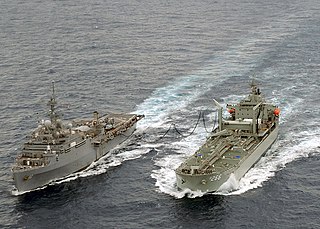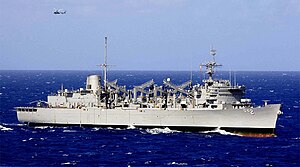History
The idea of combining the capabilities of a fleet oiler (AO), ammunition ship (AE), and refrigerated stores ship (AF) had been conceived during the Second World War by Admiral Arleigh Burke, later Chief of Naval Operations, who sought to create a single ship that would perform the functions of three vessels while simultaneously integrating into a carrier battle group. This was deemed necessary because World War II replenishments had to be scheduled well in advance due to communications problems and were subject to change due to weather or combat related reasons. On top of that the Underway Replenishment Groups of that time were slow and unwieldy. After experimenting with this "replenishment oiler" concept with the German war prize Dithmarschen (placed in service as USS Conecuh (AOR-110)), the US Navy's solution to these problems was to create a multi-product station ship, which resulted in the construction of the Sacramento class. The Sacramentos had been designed to carry more fuel and ammunition than the largest ammunition ships then in service with the US Navy. The AOEs were also designed to be much faster than previous auxiliaries at 26 knots, giving them the ability to operate in company with a carrier battle group rather than in a separate, slower replenishment group. The first two ships each received one-half of the powerplants removed from the unfinished Iowa-class battleship Kentucky, while the remaining two received new construction machinery. All four had General Electric turbines.
To fulfill the same role in the less demanding Anti-Submarine Support Aircraft Carrier (CVS) groups, the navy built the similar, but smaller and slower, Wichita-class AORs.
Construction of the unnamed AOE-5 was cancelled in 1968. [2] There are no Sacramento-class ships in service with the Navy, the last one being retired in 2005.
The ships that now fulfill this role for the U.S. Navy are the Supply-class fast combat support ships. Those ships are not commissioned ships of the Navy; rather they are operated by the Military Sealift Command.

A carrier battle group (CVBG) is a naval fleet consisting of an aircraft carrier capital ship and its large number of escorts, together defining the group. The CV in CVBG is the United States Navy hull classification code for an aircraft carrier.

The fast combat support ship is a type of replenishment auxiliary ship. Different from traditional logistic ships, the fast combat support ship is designed with high speed to keep up with the carrier battle group/carrier strike group, while the multi-product station is capable of supplying all types of necessities for the fleet.

A naval ship is a military ship that is used by a navy. Naval ships are differentiated from civilian ships by construction and purpose. Generally, naval ships are damage resilient and armed with weapon systems, though armament on troop transports is light or non-existent.

The Lewis and Clark class of dry cargo ship is a class of 14 underway replenishment vessels operated by the United States Navy's Military Sealift Command. The ships in the class are named after famous American explorers and pioneers.

The Military Sealift Command (MSC) is an organization that controls the replenishment and military transport ships of the United States Navy. Military Sealift Command has the responsibility for providing sealift and ocean transportation for all US military services as well as for other government agencies. It first came into existence on 9 July 1949 when the Military Sea Transportation Service (MSTS) became solely responsible for the Department of Defense's ocean transport needs. The MSTS was renamed the Military Sealift Command in 1970.

USS Sacramento (AOE-1) was the third ship in the United States Navy to bear the name, for both the river, and the capital city of California. She was the lead ship of her class of fast combat support ship.

USS Camden (AOE-2) was a Sacramento-class fast combat support ship, the second ship of the United States Navy named after the city of Camden, New Jersey. It combined the functions of three logistic support ships in one hull - fleet oiler (AO), ammunition ship (AE), and refrigerated stores ship (AF).

A replenishment oiler or replenishment tanker is a naval auxiliary ship with fuel tanks and dry cargo holds which can supply both fuel and dry stores during underway replenishment (UNREP) at sea. Many countries have used replenishment oilers.

USNS Arctic, formerly USS Arctic (AOE-8), is the third ship in the Supply class of fast combat support ships and is the fifth supply ship to carry the name of the region surrounding the North Pole.

The second USS Seattle (AOE-3), a Sacramento-class fast combat support ship, was laid down on 1 October 1965, at the Puget Sound Naval Shipyard, Bremerton, Washington; launched on 2 March 1968; sponsored by Mrs. William M. Allen, chairman of the board of the Children's Orthopedic Hospital Association, Seattle; and commissioned on 5 April 1969.

Underway replenishment (UNREP) or replenishment at sea (RAS) is a method of transferring fuel, munitions, and stores from one ship to another while under way. First developed in the early 20th century, it was used extensively by the United States Navy as a logistics support technique in the Pacific theatre of World War II, permitting U.S. carrier task forces to remain at sea indefinitely.

USS Conecuh (AOR-110) was a fleet replenishment tanker, originally built by F. Schichau, Danzig, in 1938 as a combination oiler and supply vessel or "Troßschiff" for the Kriegsmarine and christened as Dithmarschen. Taken over by British authorities at Bremerhaven when World War II ended, Dithmarschen was allocated to the United States Navy on 15 January 1946 by the Inter-Allied Reparations Commission.

USNS Bridge (T-AOE-10),, is the fourth ship of the Supply-class of fast combat support ships in the United States Navy. She is the second ship in the Navy named after Horatio Bridge, a Commodore who served during the Civil War. Bridge was commissioned on 5 August 1998.

USNS Rainier (T-AOE-7), is a Supply-class fast combat support ship and the third US Navy vessel named after Mount Rainier. The ship was christened on 28 September 1991 by the ship's sponsor, Mrs. Suzanne Callison Dicks, wife of Congressman Norm Dicks, and commissioned as "USS Rainier (AOE-7)", on 21 January 1995 at Bremerton, Washington.
Service Force, United States Pacific Fleet, usually known as COMSERVPAC, was a service support command of the United States Pacific Fleet from 1942 until 1973. It was the reincarnation of the former Base Force. The Service Force comprised the supply train of the fleet which includes Oilers (AO), Gasoline Tanker (AOG), Repair Ships (AR), Ammunition Ships (AE), Destroyer Tenders (AD) and Submarine tenders (AS).

Wichita-class replenishment oilers comprised a class of seven replenishment oilers used by the United States Navy from the late 1960s to the mid-1990s. The ships were designed for rapid underway replenishment using both connected replenishment and vertical replenishment.
The United States Navy Combat Logistics Force (CLF), formerly the Naval Fleet Auxiliary Force (NFAF), is a subordinate component of the United States Navy's Military Sealift Command. CLF's 42 ships are the supply lines that provide virtually everything that Navy ships at sea needs to accomplish its missions, including fuel, food, ordnance, spare parts, mail and other supplies. NFAF ships enable the Navy fleet to remain at sea, on station and combat ready for extended periods of time. CLF ships also conduct towing, rescue and salvage operations or serve as floating medical facilities. All CLF ships are government owned and crewed by civil service mariners. Some of the ships also have a small contingent of Navy personnel aboard for operations support, supply coordination and helicopter operations.

The Type 901 is a class of fast combat support ship of the Chinese People's Liberation Army Navy.
The Next-Generation Logistics Ship (NGLS) is a programme being undertaken by the United States Navy to construct a fleet of medium-sized auxiliary ships that will provide underway replenishment (UNREPS), disaster relief and logistics capabilities for combined land and sea operations. These new vessels are not intended to replace existing classes such as the John Lewis-class replenishment oilers (AO) and the Supply-class fast combat support ships (AOE) but to supplement their operations, especially in littoral waters and combat zones where larger vessels cannot be risked.















